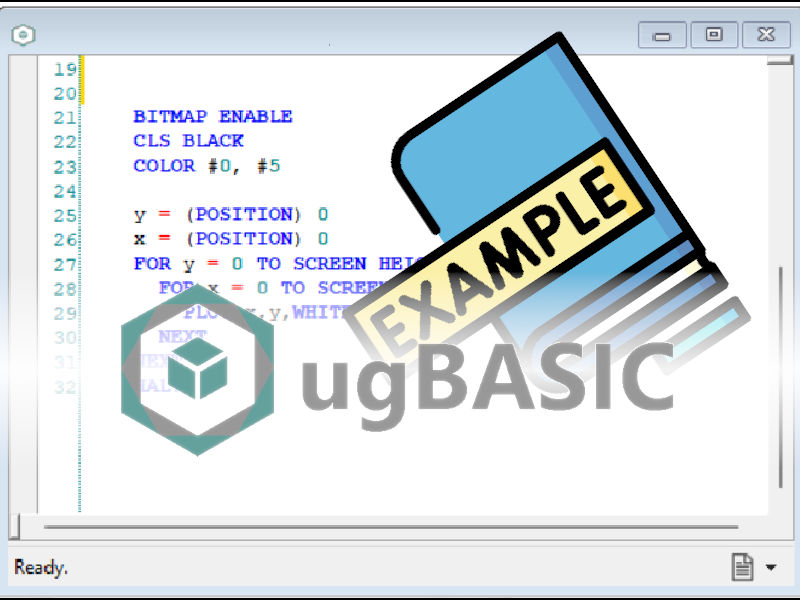SOURCE CODE ( )
)
' It is necessary to apply some techniques to reduce the memory actually
' used, so that the game can run even on rather limited platforms,
' such as ColecoVision.
' First, let's proceed to reduce the space occupied by dynamic strings.
' In ugBASIC this space, despite being dynamic, is statically allocated
' and occupies a certain memory space. With those pragmas we tell ugBASIC
' that we will never use more than 8 strings by a total of 32 bytes.
' Static strings, such as those in quotes, don't count.
DEFINE STRING SPACE 32
DEFINE STRING COUNT 8
' This procedure reads the fire button if a joystick is available.
PROCEDURE control ON JOYSTICK AVAILABLE
IF JFIRE(0) THEN
RETURN TRUE
ELSE
RETURN FALSE
ENDIF
END PROC
' This procedure reads the space bar if a joystick is not available.
PROCEDURE control ON JOYSTICK NOT AVAILABLE
IF KEY STATE(KEY SPACE) THEN
RETURN TRUE
ELSE
RETURN FALSE
ENDIF
END PROC
' ------------------------------------------------------------------
' 100 GRAPHICS HIRES 4:SET BORDER 0:SET KEY CLICK OFF:SET STATUS OFF
' ------------------------------------------------------------------
' We enable the "bitmap" graphics mode. This is the mode in which
' each individual pixel can be addressed individually, via primitive
' commands, such as those related to drawing a single pixel.
BITMAP ENABLE
' We set the border color to black, at least for those targets for
' which this instruction makes sense. Since ugBASIC is an isomorphic
' language, it does not provide an abstraction of the concept of
' "border". Therefore, if the border exists, it will be colored,
' otherwise this statement corresponds to a "no operation".
COLOR BORDER BLACK
' Let's define the (pixel) coordinates of the play field:
'
' (x1,y1) +---------+
' | |
' | |
' +---------+ (x2,y2)
POSITIVE CONST x1 = SCREEN WIDTH / 10
POSITIVE CONST x2 = x1 + (8 * ( SCREEN WIDTH / 10 ))
POSITIVE CONST y1 = SCREEN HEIGHT / 10
POSITIVE CONST y2 = y1 + (7 * ( SCREEN HEIGHT / 10 ))
' Let's define the (characters) coordinates of the play field:
'
' (,r1) --> INSTRUCTIONS
' +---------+
' | |
' | |
' +---------+
' (,r2) --> COMMAND
POSITIVE CONST r1 = 0
POSITIVE CONST r2 = ROWS-2
' Instructions string. The lenght of this string depends on
' the width of the text screen.
CONST instructions = IF(COLUMNS < 40, "press to turn", "GAME: press to turn direction")
CONST final = IF(COLUMNS < 40, "SCORE: ", "YOUR SCORE: ")
' Repeat forever
DO
' With this instruction we clear the screen, using (if possible) the color
' black. Remembering that ugBASIC is an isomorphic language, it is possible
' that the color indication is ignored, or a similar one is chosen.
CLS BLACK
' Let's memorize the status of fire and the previous state itself.
' This allow to track the fact that the fire has been released.
joy = FALSE: joyp = FALSE
' ----------------------------------------------------------
' 110 SET INK 2:PLOT 500,200;800,200;800,500;500,500;500,200
' ----------------------------------------------------------
' Let's draw the yellow box as playfield.
BOX x1,y1 TO x2,y2,YELLOW
' ------------------------------------------------------------
' 120 PRINT #101,AT 2,2:"GAME: press a key to turn direction."
' ------------------------------------------------------------
' Let's print the intructions at the center of the line.
LOCATE ,r1
CENTER instructions;
' -------------------------------------------------
' 130 SET INK 3:LET I=0:LET X=550:LET Y=220:LET S=0
' -------------------------------------------------
i = 0
x = x1+x1
y = y1+y1
s = 0
' +---------+
' | * (x,y) |
' | |
' +---------+
' Forever loop until finish.
DO
' ---------------------------
' 140 LET I$=INKEY$:LET S=S+1
' ---------------------------
' Slow down the program a bit, to make it playable.
WAIT 25 MS
' Let's record if the button has been pressed AND released.
IF joy THEN
IF control[] = 0 THEN
joyp = TRUE
joy = FALSE
ENDIF
ELSE
joy = control[]
ENDIF
' Increment the score!
INC s
' -------------
' 150 PLOT X,Y,
' 160 LOOK A
' -------------
' Take the color of destination pixel.
a = POINT(x,y)
' Draw a pixel on it.
PLOT x,y,WHITE
' ---------------------------------------
' 170 PLOT X,Y
' 180 IF I$ ≠ "" THEN LET I= (I+1) BAND 3
' ---------------------------------------
' Each time the fire / space bar is pressed, the
' direction will be changed, in a clockwise manner.
' The (i+1) increment the direction, while the AND
' 3 will limit the value from 0 to 3.
'
' 3
' ^
' 2 <-+-> 0
' v
' 1
IF joyp THEN i = (i+1) AND 3
' Reset the button.
joyp = FALSE
' -----------------------------------
' 190 IF I=0 THEN LET X=X+4:LET Y=Y+0
' -----------------------------------
' Move the point to the right.
IF i=0 THEN INC x
' -----------------------------------
' 200 IF I=1 THEN LET X=X+0:LET Y=Y+4
' -----------------------------------
' Move the point down.
IF i=1 THEN INC y
' -----------------------------------
' 210 IF I=2 THEN LET X=X-4:LET Y=Y+0
' -----------------------------------
' Move the point to the left.
IF i=2 THEN DEC x
' -----------------------------------
' 220 IF I=3 THEN LET X=X+0:LET Y=Y-4
' -----------------------------------
' Move the point to the right.
IF i=3 THEN DEC y
' ------------------------
' 230 IF A=0 THEN GOTO 140
' ------------------------
' If the underlying pixel is black, we can move
' to the next position along the selected direction.
' Oherwise, we can exit.
EXIT IF a<>BLACK
LOOP
' ---------------------------------------
' 240 PRINT #101,AT 19,12:"YOUR SCORE:";S
' ---------------------------------------
' Print the score and ends.
LOCATE , r2
CENTER final+STR$(s);
' Wait a key / fire to restart
WAIT KEY OR FIRE RELEASE
LOOP


